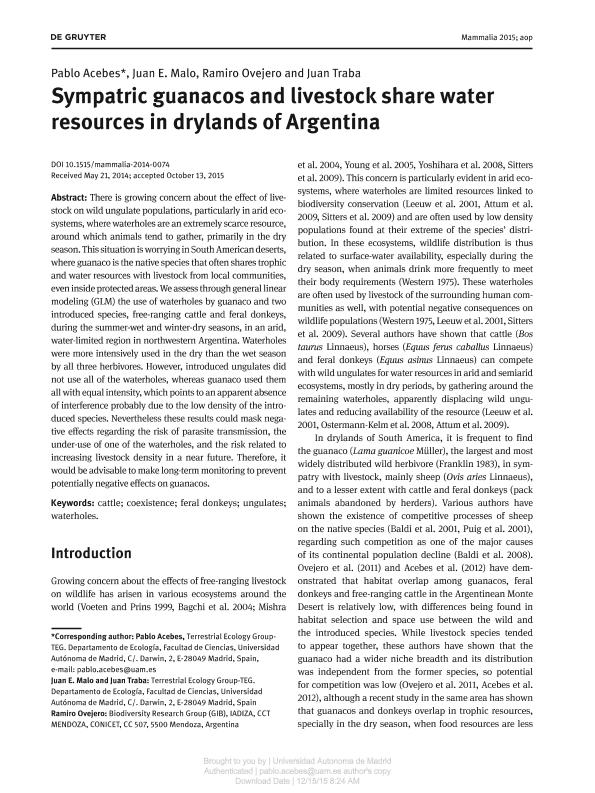Artículo
Sympatric guanacos and livestock share water resources in drylands of Argentina
Fecha de publicación:
08/2016
Editorial:
De Gruyter
Revista:
Mammalia
ISSN:
0025-1461
Idioma:
Inglés
Tipo de recurso:
Artículo publicado
Clasificación temática:
Resumen
There is growing concern about the effect of livestock on wild ungulate populations, particularly in arid ecosystems, where waterholes are an extremely scarce resource, around which animals tend to gather, primarily in the dry season. This situation is worrying in South American deserts, where guanaco is the native species that often shares trophic and water resources with livestock from local communities, even inside protected areas. We assess through general linear modeling (GLM) the use of waterholes by guanaco and two introduced species, free-ranging cattle and feral donkeys, during the summer-wet and winter-dry seasons, in an arid, water-limited region in northwestern Argentina. Waterholes were more intensively used in the dry than the wet season by all three herbivores. However, introduced ungulates did not use all of the waterholes, whereas guanaco used them all with equal intensity, which points to an apparent absence of interference probably due to the low density of the introduced species. Nevertheless these results could mask negative effects regarding the risk of parasite transmission, the under-use of one of the waterholes, and the risk related to increasing livestock density in a near future. Therefore, it would be advisable to make long-term monitoring to prevent potentially negative effects on guanacos.
Palabras clave:
CATTLE
,
COEXISTENCE
,
FERAL DONKEYS
,
UNGULATES
,
WATERHOLES
Archivos asociados
Licencia
Identificadores
Colecciones
Articulos(IADIZA)
Articulos de INST. ARG DE INVEST. DE LAS ZONAS ARIDAS
Articulos de INST. ARG DE INVEST. DE LAS ZONAS ARIDAS
Citación
Acebes, Pablo; Malo, Juan E.; Ovejero Aguilar, Ramiro Jose Antonio; Traba, Juan; Sympatric guanacos and livestock share water resources in drylands of Argentina; De Gruyter; Mammalia; 80; 5; 8-2016; 491-496
Compartir
Altmétricas




